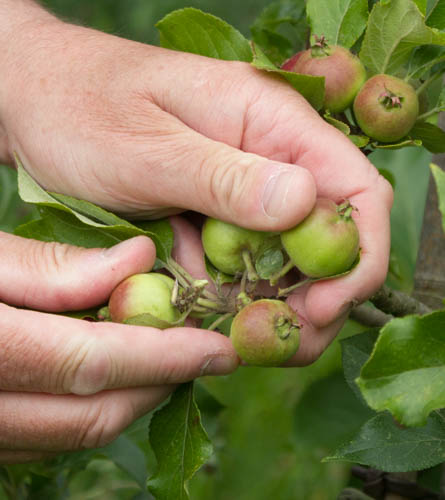
Fresh tomatoes eaten straight from the plant, are one of the great pleasures of summer. So to get the best from your plants, keep them well shaded, ventilated, fed and watered throughout the growing season and ‘pinch out’ the stem just above the fourth truss to ensure that the fruits ripen. Feed with Epsom Salts at one teaspoon per gallon, at the first signs of leaf yellowing to avoid magnesium deficiency and once the plants have set fruit, give them two or three feeds with general fertilizer to boost their health and vigor plant before reverting to high potash fertilizer for the rest of the season, then keep them constantly moist to prevent splitting. Do this and you’ll be well on your way to the plumpest most succulent tomatoes, ever.
Although apple trees shed some fruit from the end of June to early July, further thinning may be needed for a good crop of moderately sized fruit, otherwise the tree might over produce, then take a year off to recover (biennial cropping). It also improves ripening of remaining fruit and reduces fungal problems by improving air circulation. Remove the ‘king’ or central fruit and any that are blemished or damaged and any that are small or mis-shapen, leaving a fruit every four to six inches depending on the vigor of the cultivar (the average hand span is around six inches across). Thin pears too, leaving one or two fruits per cluster and apricots to three inches apart when they are the size of hazelnuts and plums with pairs of fruit six inches apart.
July is often a warm dry month, so keep an eye on watering and the condition of your plants. Water plants in the evening, poured around the roots not over the leaves and check your containers at least once a day and water even if it has rained. Water according to the type of plant – lavenders, from a Mediterranean climate have a low demand for water but bananas are watered copiously as they lose water through their massive leaves. Putting the ‘right plant in the right place’ helps, too, lavender, cistus, cotton lavender and plants from Mediterranean climates thrive on sandy soils and will only need watering until, established. Creating a circular ridge of soil around the base allows the water to pool, rather than run off, and adding plenty of well-rotted organic matter to the soil before planting, ensures that water is retained like a sponge. Water well, rather than a little and often, encouraging roots down into the soil rather than up to the surface, where they are more susceptible to drought. Don’t water established plants unless they are showing signs of stress and if possible, recycle grey water from the bath but not on edible crops and don’t use too much bubble bath, either! Mulching pots with mini bark or gravel will keep weeds down and conserve moisture, too. There are lots of practical ways you can save water. Happy gardening! Matt


